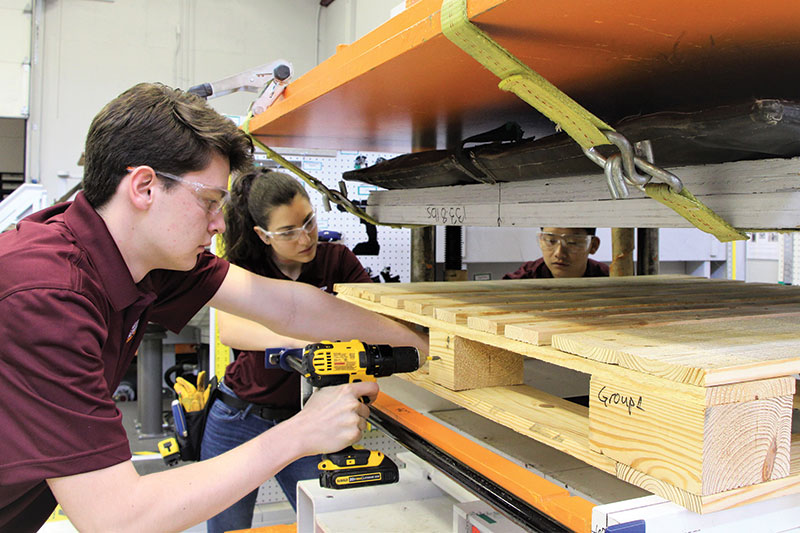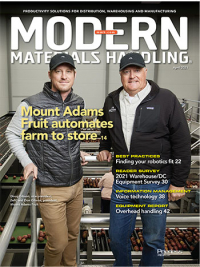When is a pallet not up to the job?
That’s exactly what they want to know at the Virginia Tech packaging center dedicated to finding better ways to protect everything in the supply chain. The idea is to figure this out before the first shipment goes awry.
There’s nothing simpler than the basic pallet. Right?
“Not so fast,” says Laszlo Horvath, who spends a whole lot more time with pallets than most of us as director of the Center for Packaging and Unit Load Design at Virginia Tech.
In the course of a year, Horvath and the center’s staff test more than 100 pallet designs. Clients such as Amazon want to know in advance if a particular pallet can protect the load it will carry. Clearly, Amazon is into packaging much beyond the individual boxes and envelopes we all receive. More on that later.
In fact, all pallets at Amazon must be certified by testing to carry specific loads. Some are for transport of loads within the company. Others are for transport of goods by Amazon merchants to the e-commerce giant’s distribution centers. And there’s good reason for all this research.
“Most people treat a pallet like a box. Only trouble is, you can’t do that,” says Horvath.
He explains that it’s not just a matter of loading up a pallet with however many pounds of product on it, and then testing to see if the pallet survives measured impacts. “A pallet reacts quite differently if it has 2,000 pounds of bottled water on it compared to 2,000 pounds of 55-gallon drums,” Horvath continues.
The key word here is “flex.” Testing determines how the pallet design flexes with the specific load on it. He explains that any pallet will flex quite differently with bottles of water on it than rigid drums, even if the weight of the two loads are equal. Almost sounds intuitive when Horvath says it.
“However, almost nobody knows this,” Horvath adds. “And if the person selecting pallets isn’t aware of the differences, those pallets rated to carry 2,000 pounds may well get crushed by the wrong 2,000-pound load.”
And the center has tested pallets for carrying everything from automotive side mirrors to vaccines. The latter was pre-pandemic. And while most of the pictures we see of vaccine shipments these days are in boxes, this one involved an aluminum pallet. “This was one of the most highly engineered pallets I’ve ever seen, and it worked great,” says Horvath. That’s especially important when talking about a $10 million pallet load.
To help with matching pallet designs to products, the center has developed research-based software to help companies match pallet designs to loads. That’s another service provided by the center, which is supported by its testing program and its 12 corporate members.
And while the center has historically been focused on pallets, Horvath is expanding into research tied into other modes of packaging including e-commerce packages. His latest interest is to figure out what can be done to prevent damage to your grandmother’s fragile birthday gift. And who isn’t interested in a smiling grandmother?

Article Topics
Packaging News & Resources
Registration open for Pack Expo International 2024 Pack Expo East has largest show to date Optimize Parcel Packing to Reduce Costs CMC Packaging Automation North America unveils Tech Center in Atlanta PACK EXPO East brings latest packaging technologies to Philadelphia Loftware’s cloud-based labeling solutions take center stage Flexcon unveils its innovative bin solutions More PackagingLatest in Materials Handling
Geek+ and System Teknik deploy PopPick solution for pharmacy group Med24.dk Beckhoff USA opens new office in Austin, Texas Manhattan Associates selects TeamViewer as partner for warehouse vision picking ASME Foundation wins grant for technical workforce development The (Not So) Secret Weapons: How Key Cabinets and Asset Management Lockers Are Changing Supply Chain Operations MODEX C-Suite Interview with Harold Vanasse: The perfect blend of automation and sustainability Consultant and industry leader John M. Hill passes on at age 86 More Materials HandlingAbout the Author
Subscribe to Materials Handling Magazine

Find out what the world's most innovative companies are doing to improve productivity in their plants and distribution centers.
Start your FREE subscription today.
April 2024 Modern Materials Handling

Latest Resources












